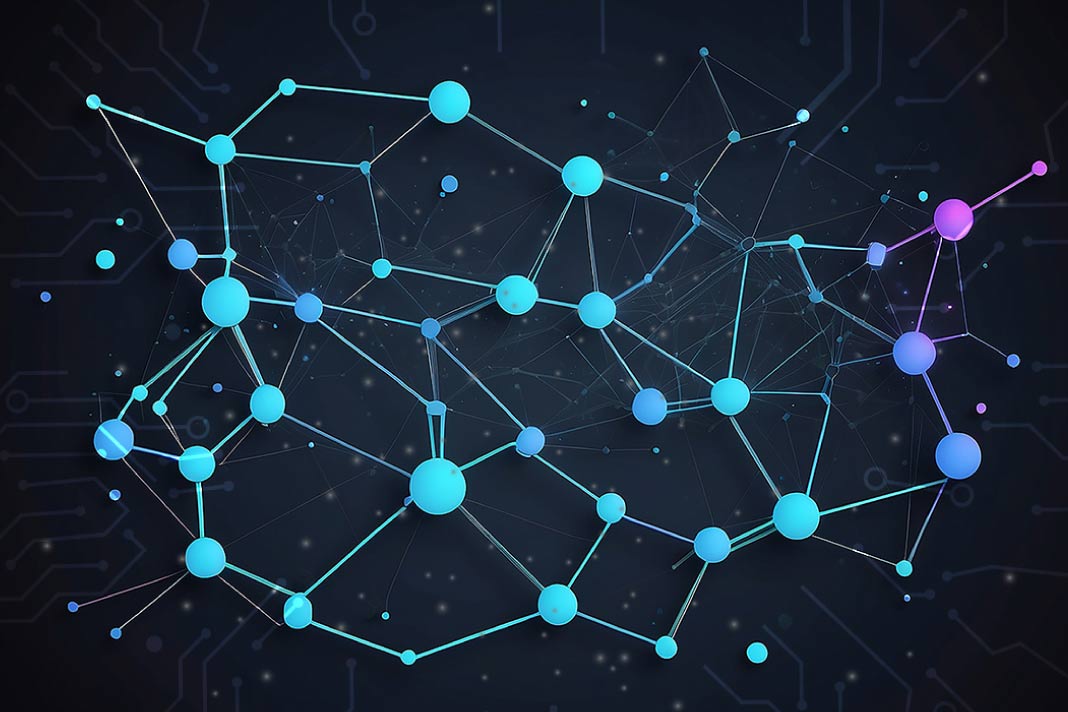Neural networks have been adapted to leverage the structure and properties of graphs. We explore the components needed for building a graph neural network – and motivate the design choices behind them.
What are Graph Neural Networks (GNNs)?
GNNs are a powerful class of deep learning models that process graph-structured data. Unlike traditional neural networks optimized for numerical data, GNNs excel at understanding the relationships and interactions between entities represented as nodes and edges in a graph. This makes them well-suited to various tasks, including:
- Social network analysis: Predicting user behavior, recommending connections, and detecting communities.
- Fraud detection: Identifying suspicious transactions or activities in financial networks.
- Molecule design and drug discovery: Predicting molecular properties and simulating interactions.
- Traffic forecasting: Predicting traffic flow and congestion on road networks.
- Recommendation systems: Recommending products, movies, or other items based on user preferences and connections.
Key Concepts and Working Principles
- Graph Structure: A graph consists of nodes (representing entities) connected by edges (representing relationships). GNNs can process graphs of various sizes, complexities, and directions (directed vs. undirected).
- Node Features: Each node can have additional attributes (e.g., user age, product price). These features are essential for capturing individual characteristics.
- Message Passing: The core concept of GNNs lies in the iterative message passing between nodes. Each node aggregates information from its neighbors, updates its features, and further passes it. This process allows GNNs to learn representations that capture the context and relationships within the graph.
- Aggregation Functions: GNNs use various aggregation functions, such as summation, concatenation, or attention mechanisms, to combine information from neighbors during message passing.
- Output Layer: The final layer of a GNN typically uses a readout function to transform node representations into predictions for specific tasks, such as node classification, link prediction, or graph property prediction.
Training and Optimization
- Loss Functions: Like other deep learning models, GNNs are trained by minimizing a loss function that measures the difference between predicted and actual outputs. The choice of loss function depends on the specific task.
- Optimization Algorithms: Gradient-based optimization algorithms, like Adam or SGD, are commonly used to update the parameters of the GNN.
- Regularization: Techniques like dropout and spectral normalization help prevent overfitting and improve generalization performance.
Types of Graph Neural Networks
- Convolutional GNNs (ConvGNNs): Inspired by convolutional neural networks, ConvGNNs use localized filters to aggregate information from neighborhoods. Examples include Graph Convolutional Networks (GCNs) and ChebNet.
- Recurrent GNNs (RecGNNs): These GNNs utilize recurrent structures like LSTMs or GRUs to incorporate temporal information or handle dynamic graphs. Examples include Gated Recurrent Units for Molecules (MoleculeRNN) and GraphRNN.
- Attention-based GNNs: These GNNs employ attention mechanisms to focus on important neighbors during message passing selectively. Examples include Graph Attention Networks (GATs) and Transformer-based GNNs.
Advantages and Limitations
- Strengths:
-
-
- Expressive power for complex graph-structured data
- Ability to capture relational information beyond node features
- Adaptability to diverse graph structures and tasks
-
- Weaknesses:
-
- It can be computationally expensive for large graphs
- It may require specialized hardware for efficient training
- Interpretability of internal representations can be challenging
Future Directions and Applications
- Explainable GNNs: Research efforts aim to develop interpretable GNN models that provide insights into their reasoning process.
- Large-scale GNNs: Techniques like distributed training and hardware acceleration are being explored to handle massive graphs efficiently.
- Novel applications: GNNs explore new domains like protein-protein interaction modeling, natural language processing, and robotics.
Conclusion
GNNs have emerged as a powerful tool for leveraging the power of graph-structured data, demonstrating their versatility across various domains. By understanding their core principles, strengths, and limitations, we can effectively utilize their potential to solve complex problems and make informed decisions in a connected world.



